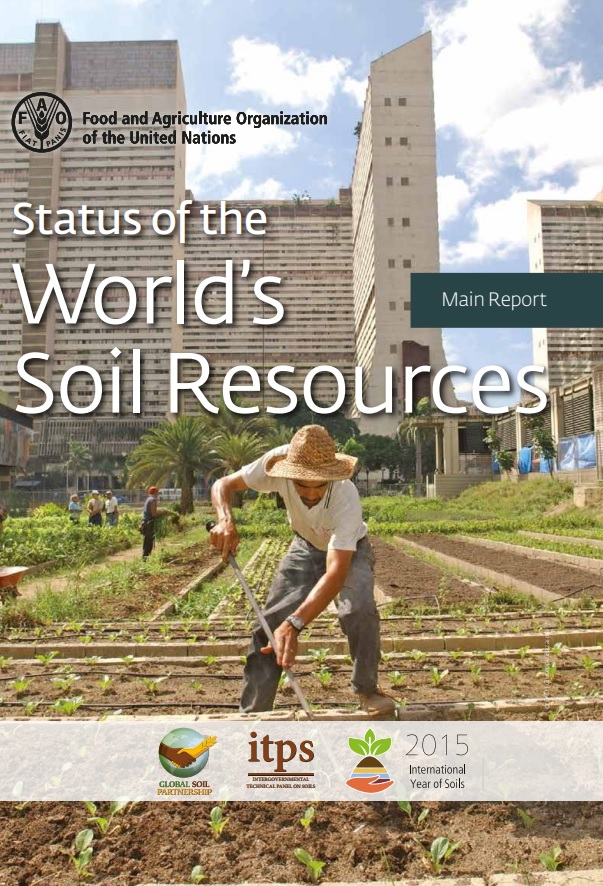Overview
The main objectives of The State of the World’s Soil Resources are: (a) to provide a global scientific assessment of current and projected soil conditions built on regional data analysis and expertise; (b) to explore the implications of these soil conditions for food security, climate change, water quality and quantity, biodiversity, and human health and wellbeing; and (c) to conclude with a series of recommendations for action by policymakers and other stakeholders.
The book is divided into two parts. The first part deals with global soil issues (Chapters 1 to 8). This is followed by a more specific assessment of regional soil change, covering in turn Africa South of the Sahara, Asia, Europe, Latin America and the Caribbean, the Near East and North Africa, North America, the Southwest Pacific and Antarctica. (Chapters 9 to 16). The technical and executive summaries are published separately.
In Chapter 1 the principles of the World Soil Charter are discussed, including guidelines for stakeholders to ensure that soils are managed sustainably and that degraded soils are rehabilitated or restored. For long, soil was considered almost exclusively in the context of food production. However, with the increasing impact of humans on the environment, the connections between soil and broader environmental concerns have been made and new and innovative ways of relating soils to people have begun to emerge in the past two decades. Societal issues such as food security, sustainability, climate change, carbon sequestration, greenhouse gas emissions, and degradation through erosion and loss of organic matter and nutrients are all closely related to the soil resource. These ecosystem services provided by the soil and the soil functions that support these services are central to the discussion in the report.
In Chapter 2 synergies and trade-offs are reviewed, together with the role of soils in supporting ecosystem services, and their role in underpinning natural capital. The discussion then covers knowledge – and knowledge gaps – on the role of soils in the carbon, nitrogen and water cycles, and on the role of soils as a habitat for organisms and as a genetic pool. This is followed in Chapter 3 by an overview of the diversity of global soil resources and of the way they have been assessed in the past.
Chapter 4 reviews the various anthropogenic and natural pressures – in particular, land use and soil management – which cause chemical, physical and biological variations in soils and the consequent changes in environmental services assured by those soils.
Land use and soil management are in turn largely determined by socio-economic conditions. These conditions are the subject of Chapter 5, which discusses in particular the role of population dynamics, market access, education and cultural values as well as the wealth or poverty of the land users. Climate change and its anticipated effects on soils are also discussed in this chapter.
Chapter 6 discusses the current global status and trends of the major soil processes threatening ecosystem services. These include soil erosion, soil organic carbon loss, soil contamination, soil acidification, soil salinization, soil biodiversity loss, soil surface effects, soil nutrient status, soil compaction and soil moisture conditions.
Chapter 7 undertakes an assessment of the ways in which soil change is likely to impact on soil functions and the likely consequences for ecosystem service delivery. Each subsection in this chapter outlines key soil processes involved with the delivery of goods and services and how these are changing. The subsections then review how these changes affect soil function and the soil’s contribution to ecosystem service delivery. The discussion is organized according to the reporting categories of the Millennium Ecosystem Assessment, including provisioning, supporting, regulating and cultural services.
Chapter 8 of the report explores policy, institutional and land use management options and responses to soil changes that are available to governments and land users.
The regional assessments in Chapters 9 to 16 follow a standard outline: after a brief description of the main biophysical features of each region, the status and trends of each major soil threat are discussed. Each chapter ends with one or more national case studies of soil change and a table summarizing the results, including the status and trends of soil changes in the region and related uncertainties.
Contents
- Global soil resources
- The role of soils in ecosystems proceses
- Global Soil Resources
- Soil and Humans
- Drivers of global soil change
- Global soil status, processes and trends
- Soil change : impacts and responses
- Governance and policy responses to soil change
- Regional Assessment of Soil Changes in Africa South of the Sahara
- Regional Assessment of Soil Change in Asia
- Regional Assessment of soil changes in Europe and Eurasia
- Regional Assessment of Soil changes in Latin America and the Caribbean
- Regional Assessment of Soil Changes in the Near East and North Africa
- Regional Assessment of Soil Changes in North America
- Regional Assessment of Soil Changes in the Southwest Pacific
- Regional Assessment of Soil Changes in Antartica
- Annex / Soil groups, characteristics, distribution and ecosystem services



